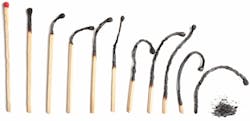Between world events and industry conditions, people remain in a prolonged state of stress. Many of your team members may be carrying those worries without even realizing it.
A pre-pandemic study from Deloitte found that 42% of workers left a job specifically because of burnout, and now the predictions are that number will rise.
Today, as leaders and managers, we have to understand our people better and know that work has become more of a coaching and mentorship environment than ever before. You have to be more self-aware than your employees to recognize burnout and provide employees with the tools to handle it.
How to Recognize Symptoms of Burnout
Some people who are burned out will become more irritable or short-tempered. Those situations are actually easier to deal with because you can say, “Whoa, what’s going on right now?” But there are others who tend to over engage with work and will take on more because they feel like everything else is out of control. This person could generally be organized and capable, then might suddenly become overwhelmed. It could spiral from stress to worthlessness and ineffectiveness.
RELATED: Feeling Super Fried? Contractors at High Risk for Burnout
In those scenarios, it’s helpful to say, “You’ve never done this before, and that’s a red flag for me, and I’m worried about you.” Take the walls down and see if they can talk about it.
Some people might not want to discuss it at that moment, but just having the conversation will show that person that you’re noticing something and pique their interest and self-awareness.
Knowing your people as individuals helps when recognizing burnout. It allows you to put together the data points of who that person was before the change in their behavior.
A New Form of Leadership
We can’t lead how we’ve always led. The question we’re looking at today is how you use yourself as a vehicle to support your organization, and that includes setting the right example.
Having a work-life balance has become a throwaway term, yet it’s imperative that any leader implements self-care. We need to be as healthy as possible in mind, body, spirit, and heart.
Having a work-life balance has become a throwaway term, yet it’s imperative that any leader implements self-care.
For example, we always tell others to take time off, but we don’t practice what we preach. In our leadership teams, we coach each other on stuff like this and call each other out on our behaviors.
A Nuanced Approach to Burnout Recovery
As leaders, it’s also not one size fits all when it comes to managing people. Instead, there’s a deeper and more nuanced experience.
One employee might think they have too much work: that’s a workload problem. Another might be okay with how much they have to do, but see a peer not taking on their level of work: that’s a fairness problem. Someone could feel as if they’re not appropriately awarded for their work: that’s a compensation problem. You have to make sure you’re connecting with the individual at each one of those levels and then coaching from there.
When it comes to teams in general, if someone is feeling unheard, unsupported, or slighted, you’re not going to get the value out of that person. They will not live up to their potential. And ultimately, that hurts the company.
Allison Iantosca is owner and president and Angela Prizio is director of finance and operations at F.H. Perry Builder in Hopkinton, Mass.
